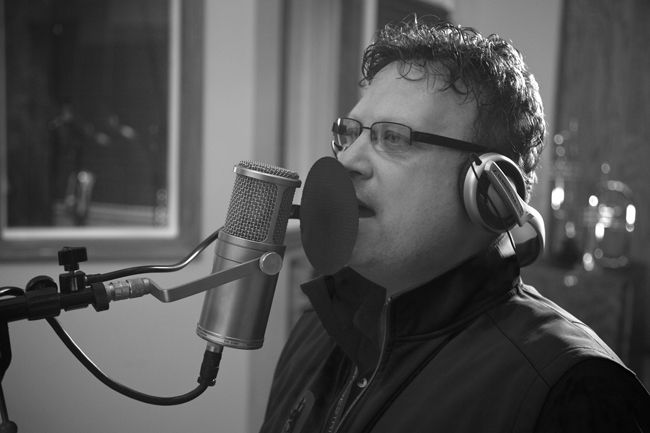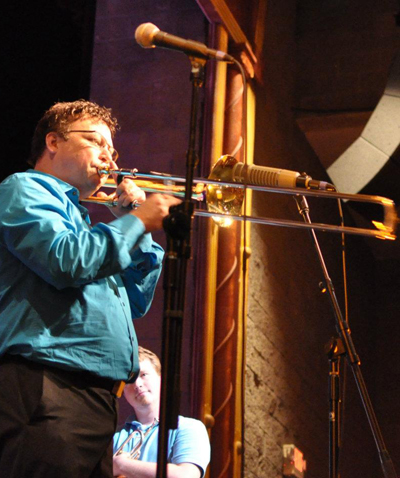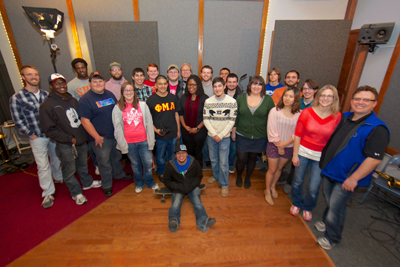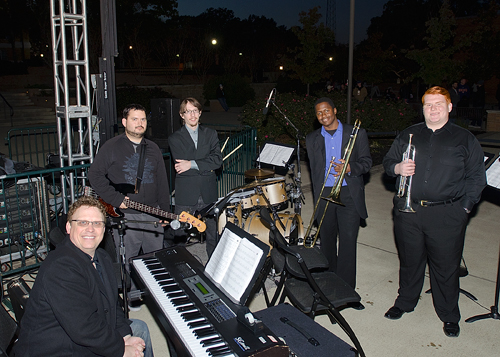Professor Works To 'Jazz Up' Campus, Bring Prestige To Music Program
March 22, 2013
SHSU Media Contact: Alexis Andrei
 |
| Since joining the School of Music in 2008, director of jazz studies Aric Schneller has worked to boost the prestige of the program by rebuilding the curriculum, taking students into the recording studio, and naming SHSU's annual jazz festival after jazz trombone legend Bill Watrous, which is now in its third year under Watrous's name. The festival will be held April 5-6 on the SHSU campus. —Submitted photos |
When Aric Schneller joined the Sam Houston State University faculty in the fall of 2008, he saw a thriving music department and the potential for a flourishing jazz program. Strapped with only his hope, skills and dedication to the art of creating a “culture of jazz” at SHSU, he has jumpstarted a program whose accomplishments can be seen from the successes of alumni to the establishment of SHSU’s first named jazz festival, the Bill Watrous Jazz Festival.
“I came to Sam Houston for more than just the job; I care about my students and teaching. I wanted to create a successful program that promoted a culture of jazz and jazz education,” said Schneller, assistant professor and director of jazz studies.
Before he came to SHSU, Schneller started out as an aspiring undergraduate pursing a Bachelor of Music degree in trombone performance from the University of Montana. His drive to pursue a higher education led him to receive a Master of Music degree in jazz studies from the University of North Texas, a Master of Music in vocal performance from Boston University, and a candidacy for a Doctorate of Musical Arts in trombone performance from the University of North Texas.
“I wanted to pursue different avenues of music so I could augment my level of playing and teaching,” he said. “As a student, I began to set goals of one day starting my own jazz program and a named festival. But what I really wanted was to revive the importance of America’s great art, jazz, and to be the impetus that inspired a culture of jazz education.”
 Schneller began his professional teaching career at Idaho State University, where he served as a sabbatical replacement and “taught everything from trombone lessons to leading the jazz band.” He was asked to stay on for the spring and take the jazz band on a tour of Europe; this became his inspiration to create a jazz program.
Schneller began his professional teaching career at Idaho State University, where he served as a sabbatical replacement and “taught everything from trombone lessons to leading the jazz band.” He was asked to stay on for the spring and take the jazz band on a tour of Europe; this became his inspiration to create a jazz program.
“A lot of schools have a jazz program on paper, but in reality it’s just a jazz band,” Schneller said. “After my tour of Europe I realized the necessity of having someone step in and work hard to create a well-rounded, functioning jazz program for the students that really wanted to delve into the art.”
After accepting the job at SHSU, he had one goal in mind: “to bring back the great jazz tradition of Sam Houston.”
The Bill Watrous Jazz Festival technically is the oldest jazz festival in Texas, occurring this year for the 54th year, April 5-6.
“Sam Houston also has a history of famed alumni from the program like Jerry Cocker, David Cathy and Bob ‘Doc’ Morgan,” Schneller said.
In his early days at SHSU, Schneller respected the traditions created by retired School of Music chair Rod Cannon; however, he wanted to push the band forward in a new direction.
“I first worked with a graduate student who helped me get acclimated to Sam Houston’s culture,” Schneller said. “I had to get to know the students and how they absorbed information before I could begin enrolling them in my vision and that started slowly with teaching the jazz ensembles to introducing new classes like jazz improvisation. I had to gently lead the students from ground zero to the jazz language.”
Starting first with frequent jazz concerts, he began to build the curriculum; he then introduced the jazz improvisation class, which focuses on taking classically trained musicians out of their element and making them perform a transcription—a notation of a recorded sound or piece—at the end of the semester for a live audience.
After this class gained popularity, he established the jazz keyboard class, which focuses on musicians of all instruments learning how to play basic jazz chord progressions. Soon after that, he introduced a jazz arranging private study. Jazz arranging is the art of preparing and adapting an already-written composition for presentation in form different from the original. After the students finish their final project, the jazz ensemble performs their arrangement.
“I learned through my education that it is imperative that students who want to learn, teach and play jazz be able to do it through a variety of outlets to make themselves more marketable. Every jazz(er) should be able to play a basic chord progression on the piano fluidly and should be able to arrange or compose a piece for an ensemble,” Schneller said.
In addition to the curriculum available for students, Schneller wanted to “stay true to the tradition of jazz” by taking the ensembles in the studio and recording albums.
“Our history of jazz is recordings, where as in western history it’s printed document. Jazz is an oral tradition, and in order for us to complete the circle, we needed to have a historical log of what we’re doing,” Schneller said.
Every two years the SHSU jazz ensemble records an album and DVD for distribution. The first album, entitled “When You’re Smiling,” was recorded in 2010 and was released in 2012. In April, the 2012 album “MacArthur Park” will be released.
Schneller also finds it important to expose his students to performance opportunities. One of the biggest performance opportunities and chance for exposure lies at the annual Texas Music Educators Association convention in San Antonio.
“It’s extremely competitive to be able to perform at TMEA; I applied when I first got here twice and we didn’t make it,” he said. “I got the inspiration to do a clinic at TMEA and bring the band, so people could hear us. You have to create opportunities and be bold to make it in this industry.”
By 2010, all of his hard work and the multifarious facets of the program he was building started to develop, so Schneller began to focus on rounding it out.
“I wanted to create a jazz program with a jazz degree, and right now we are getting at the point where we are going to create a jazz studies emphasis. I’ve taught all the classes for the past four years as kind of a ‘pilot’ and hopefully in the fall of 2014, the jazz studies emphasis will be available at both the undergraduate and graduate level,” he said. “Once my classes were introduced, our first album was recorded and we made it to TMEA, I began to focus on my dream of creating a named jazz festival.”
 |
| (Above) The 2012-13 SHSU Jazz Ensemble. (Below) Schneller and his jazz students, who performed at the Tree of Light Ceremony. |
 |
The difference between a jazz festival and a named jazz festival is that a named jazz festival features and honors a jazz musician. With less than 10 in the United States, Schneller’s Bill Watrous Jazz Festival has put SHSU in the spotlight.
“Bill Watrous came out for a fall tour in 2009 and performed with the jazz ensemble; the night before he left, I had a dream to utilize this great resource and create a named festival,” Schneller said. “I asked him and he said yes and nine months later we created the first Bill Watrous Jazz Festival that was inaugurated in the spring of 2011.”
Watrous is considered a jazz trombone legend, having recorded with jazz luminaries such as Quincy Jones, Maynard Ferguson, Johnny Richards, and Woody Herman. He also played in the television band for Merv Griffin’s show from 1965-1968 and has continued to work actively since the 1980s as a bandleader, studio musician, and performer at various jazz clubs. He is currently is on faculty at the University of Southern California.
“Bill is a musician’s musician; he comes from the ‘golden age of jazz’ and is a dying breed,” Schneller said. “When I was in college, he visited my campus and taught me a valuable lesson about ‘paying your dues’ in this business, not because you have to, but because you love doing this.
“Even at 73 he still plays and is committed to the festival and to jazz education,” he said. “I knew that when we brought him in, his name would put Sam Houston in the spotlight and offer a once in a lifetime experience for our students.”
The Bill Watrous Jazz Festival is held annually and features Watrous as the guest of honor. In addition to performances by Watrous, another major jazz artist is brought in. Previous guest artists have included famed trumpeter Von Nark, esteemed vocalist and member of the Air Force’s “Airmen of Note” Lynn Roberts, and, this year, legendary jazz saxophonist Bob Mintzer.
“It’s very important to feature the different instruments every year, and we hadn’t had a major jazz saxophonist at Sam Houston since I started,” Schneller said. “It’s important to switch instruments every year so we can expose the student body and specific musicians to the talent.”
During the festival, middle schools, high schools and community colleges are invited to compete for prizes based on the judge’s assessment of their musicianship. In addition to the competition, after each band plays, they are awarded a clinician session with a particular judge.
Staying true to his dedication to jazz education, Schneller requires each participating band to listen to two other bands because “one of the cornerstones of jazz is listening.”
The instrument manufacturer Conn Selmer also has a booth set up during the festival to allow students to try new instruments.
In addition to the finale performance at 7:30 p.m. each night with Mintzer, Watrous and the jazz ensemble, Mintzer gives an hour-long clinic each day, which is free and open to the public.
“It’s a humbling experience seeing all that you’ve worked so hard for amount to something great,” Schneller said. “I want to keep growing the jazz festival, get the undergraduate and graduate degree in place, keep applying for performance opportunities, create an endowment for the festival to keep it going and get Bill an honorary doctorate for all the work he’s done for jazz education.
“It’s a pretty good life being able to keep jazz history alive and promote jazz education, in order to do this business, like music, it definitely has to come from the heart,” he said.
For more information, call the GPAC Box Office at 936.294.2339 or visit http://www.shsu.edu/~music/events/jazz/.
- END -
This page maintained by SHSU's Communications Office
Associate Director: Julia May
Manager: Jennifer Gauntt
Located in the 115 Administration Building
Telephone: 936.294.1836; Fax: 936.294.1834
Please send comments, corrections, news tips to Today@Sam.edu.

 SamWeb
SamWeb My Sam
My Sam E-mail
E-mail

